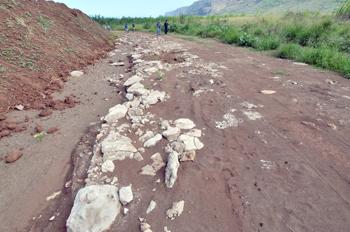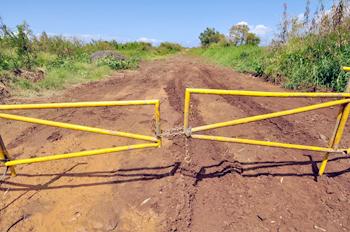POLIHALE STATE PARK — A group of concerned Westside residents met Wednesday morning at the entrance to Polihale State Park not to drive to the 17-mile-long beach to surf or cast a fishing line but to learn more about the
POLIHALE STATE PARK — A group of concerned Westside residents met Wednesday morning at the entrance to Polihale State Park not to drive to the 17-mile-long beach to surf or cast a fishing line but to learn more about the reasons one of their favorite spots was off-limits and to offer their help to the government to reopen it.
Kekaha resident Bruce Pleas told the assembled parties that state funds could take up to two years to arrive, leaving damage to the access road and other infrastructure unaddressed and the park unenjoyed, and that the only way to get the job done quicker was to get the community involved.
Senate Majority Leader Gary Hooser, D-Kaua‘i-Ni‘ihau, said the state would be unlikely to kick in much money for maintenance because the state is looking at a $1 billion budget shortfall, “the worst financial situation in the state’s history,” and that funding was extremely tight.
Pleas said community volunteers would be donating their time, equipment and expertise to do the necessary improvements to the entry road, and said there is in the works a nonprofit group that will accept monetary donations to offset costs like fuel for the equipment and food for the volunteers.
“I’m really shooting for the end of the month,” Pleas said, noting that timeline was a best-case scenario and that many tasks stand between the current condition and the park reopening. Expected wet weather next week could delay the work.
Specifically, a plantation-era bridge roughly one mile in from the highway gate sustained damage during mid-December storms that caused flooding and rockslides, making officials wary about its safety. Until the bridge is deemed passable, no vehicles, whether for maintenance or recreation, will be allowed to pass the gate.
Officials said the first order of business would be to remove debris that was lodged under the bridge in the years since the sugar plantation stopped conducting its regular maintenance of the road. Because the channel has been widened and deepened in the months since the heavy rains, the existing concrete footings may not provide sufficient stability to the structure.
After the area is cleared, Lihu‘e architect Ron Agor will gauge the bridge’s structural integrity.
“I’m going to evaluate it in a manner such that I may be putting a limited load on it, just so that the public can use it for recreation,” Agor said in a Wednesday phone interview. “I have confidence that the regular maintenance equipment will be able to use the bridge by the time I’m done with it. I’ll be probably be limiting it to that and not necessarily to what it was designed for, double trailer cane haul trucks.”
Agor said he had already been out to the site to see the bridge, but that he would need it to be cleaned out before he could be certain what work, if any, would need to be done. He said the clearing operation is set to begin Monday and he hopes to have answers by the middle of next week.
“I have a suspicion that some of the vertical supports under the bridge could have been compromised. If they’re gone, then I’ll find the existing footings and recommend getting volunteers to replace the vertical struts,” Agor said. “If the materials are available, it could be done in two weeks time. The target is to get Polihale accessible to recreational users in a couple weeks.”
DLNR State Parks Program Manager Steve Thompson said concerns about the bridge’s safety are to be addressed first and foremost.
“Our marching orders are that we can’t open this road until that bridge is safe for public transportation,” said Thompson, who added the “good news” is that perhaps half of all the work that was needed to reopen the park has already been completed, while “the rest is lined up with community volunteers.”
Thompson said DLNR can already turn the water on for the first three of the five public restrooms, and that two of four major washouts on the access road have been patched up. Remaining on the to-do list are fixing the bridge, the two remaining washouts, grading improvements to the access road and restoring water to the fourth restroom.
The fifth restroom, nearest Na Pali, sustained major damage when it was struck by cascading rocks and could be removed altogether. Even when the park does reopen, users will likely be unable to drive past the parking lot adjacent to the fourth restroom, as rocks littered across the road have made it all but entirely impassible.
Pleas said the area could be “culturally sensitive” and that Native Hawaiian groups will likely be consulted before any work is done to restore the road due to the possibility that a nearby heiau or other cultural artifacts were pushed downhill.
For that reason, fishermen or boaters who launch their vessels from “the point” nearest Na Pali will likely need to drive along the beach for a longer distance even after the park reopens, Pleas said. Driving on state and county beaches is illegal, although the law is rarely enforced.
Until then, the park’s closure will impact the local economy in addition to recreational users.
Ivan Slack and Joshua Comstock, owners of Na Pali Kayak, said their company is one of three business — Outfitters Kaua‘i and Kayak Kaua‘i are the others — that draw their livelihood from guiding visitors from Ha‘ena on the North Shore to Polihale on the Westside, all via kayak. Company vans need access to Polihale to pick up exhausted boaters at the end of the 11-mile paddle, and if the park remains closed, the companies could go belly-up.
“Our survival is dependent on it,” Slack said. “We’re all on the same page.”
Slack and Comstock said they and their like-minded would-be competitors will all make financial contributions to the nonprofit organization in an effort to get Polihale open before their busy season — summer — is wasted. The tours are not run during winter due to heavier surf and wetter weather.
Agor, who said he will be donning his “volunteer hat” for the bridge inspection, said he was encouraged by the involvement of Kaua‘i’s people and state officials’ willingness to accept the much-needed assistance.
“I really appreciate the recreational users stepping up to the plate and helping the state. Sometimes government says ‘we don’t want volunteers to get involved’ and there is a year or two wait,” Agor said. “Polihale is one of the best recreational areas for the locals, especially on the Westside. I’m happy that Kaua‘i volunteers are hard at work.”
• Michael Levine, staff writer, can be reached at 245-3681 (ext. 252) or via e-mail at mlevine@kauaipubco.com




